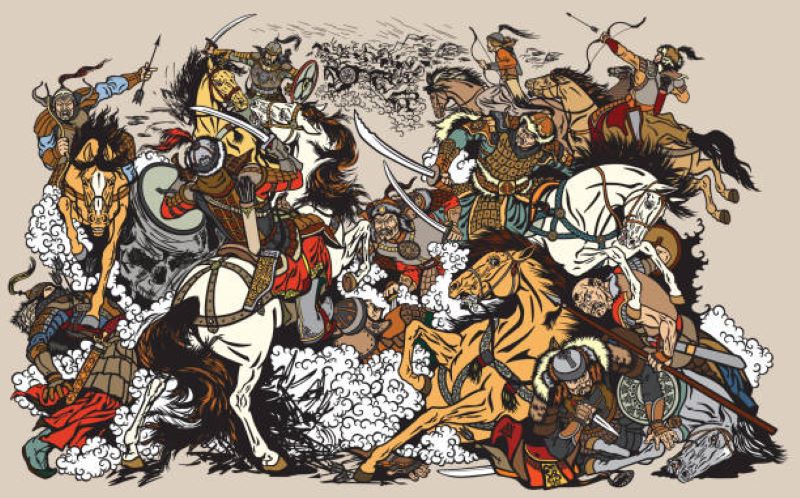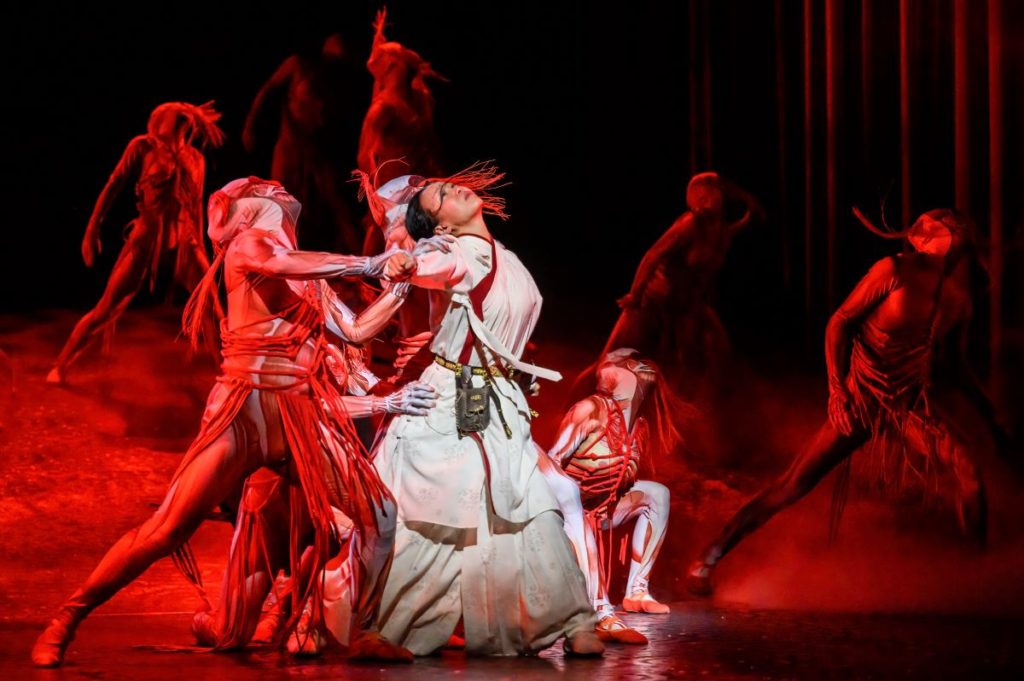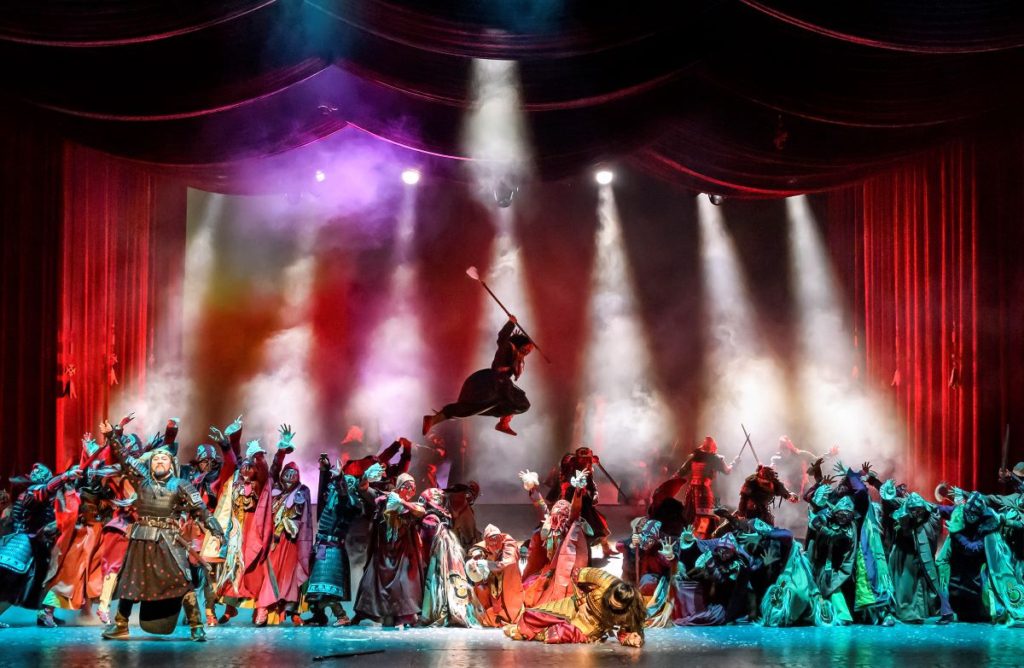The Mongol Khan is the first ever Mongolian show to be staged in the UK. An epic Mongolian production marking the 60th anniversary of diplomatic relations between Mongolia and the UK.
This production is directed by Hero Baatar, whom I had the pleasure of meeting at the London Coliseum, where the show is performed from 17 November until 02 December 2023.
His name was the first thing that puzzled me. The word BAATAR is included in the name of Mongolia’s capital city – Ulaanbaatar which means ‘Red Hero’. So the director’s name is ‘hero’ in English and in Mongolian. Before discussing The Mongol Khan I asked him about this. It turned into a splendid insight into a fascinating culture.
The importance of being Baatar
‘Baatar is a very common Mongolian name. It means ‘soldier’. Every family with a male offspring has one child named Baatar. This is often combined with a second name to help distinguish between them’, explains Hero Baatar through his interpreter.
‘Were you the eldest son in your family? I asked. ‘No’ says Baatar, ‘I am the last of several siblings, all of them female’. He went on, joyfully, to explain how the naming of children is an important ceremony: ‘After a child is born, the father whispers, three times, in the baby’s ear the name given.’ And with a broad dramatic gesture and a smile, Baatar adds ‘with the third whisper, the baby wakes up to the sound of his name.’
A great deal of meaning is attributed to names in Mongolian’s culture. The second name added to Baatar can be associated with strong metals such as iron and bronze or strong colours.
Hero and Baatar explains that the prefix Hero to his birthname is essentially a trademark, to distinguish this director and animator from many other Baatar. ‘This is a professional name card’ he adds with a warm smile.
Hero Baatar – the artist.
He grew up in the most sparsely inhabited nation on earth, with a population of 3.4 million in a country more than six times the size of UK. For the country to function and develop the inhabitants must have more than one trade. Our Hero is true to this culture of multiple trades and talents: ‘I am a painter by profession, an artist. I work in the creative industry. I am a cartoon artist, animation film producer. Some of my animations are for children and some for adults.’ And of course he is also theatre director.

A glimpse into Mongolia and its history
Baatar is keen to set the scene before we discuss The Mongol Khan, to avert some preconceived misconceptions about his country. ‘Firstly’ he says ‘the Mongols are not real nomads or vagabonds, as some may think. The Mongols have always been a pastoral society that has lived for thousands of years on their own land for generations. It’s almost like sedentary because we have permanent homes, the only difference is that the pastoral herders have four quarterly campgrounds, where they move and stay, tending their livestock following the changes of four seasons within their boundaries. Therefore, this should be understood correctly.
Secondly, in our history, the Mongols established at least four great empires. In the land of Mongolia, there existed great empires such as the Hun Empire, Turkic Empire, 13th-century Great Mongol Empire known as Chinggis Khaan’s Empire, and the Great Yuan Dynasty. These great empires were established by the pastoral Mongols on this plain steppe. In that sense, Mongolia is a country and the nation that has existed on the junction of many diverse cultures on the plateau of Central Asia, all of which have been imbued and contained in the rich pool of our Mongolian history, rich culture, and heritage.”

The Mongol Khan – A Mongolian rhapsody.
The initial idea of staging the “Mongol Khan” play was developed during the Covid pandemic, or 2-3 years ago. The reason I got this idea was that I was very close to Bavuu Lkhagvasuren, a Mongolian poet and playwright. He told me “You should direct exactly this playscript on stage”. The first idea was to direct this beautiful play without a stage setting or with human-stage, which could be compact and mobile so that we could go on tour like us, Mongols – the true nomad-herders. So, the initial idea was to design the stage with solutions suitable for this idea and the stage should have as less settings as possible. Another interesting point was derived from the unique style of Mongolian traditional painting. Mongolian painting is distinct with every element and character illustrated precisely and openly on a flat background. Adhering to this style, the stage was to be inclined towards the audience or low on the front and higher on the back so that the stage is seen in the same manner as our traditional painting is displayed. Most of the stage design solutions were discussed with the playwright himself.’
The show involves a haunting original score, dance and puppetry inspired by the nomadic tradition of the steppe. It is a political drama but primarily about different aspects of love – mothers, couples, affairs, a political leader’s love of the people. The love for your country is above everything else. The philosophy of the leader, the Khan, is that he is the one who should be ready to sacrifice everything for the country. This story is the success behind the destiny. The play is about the leader who can lead his people and can do anything for his country. The country comes first. However, when the empire is on the brink of collapse, then greed, deceit, betrayal dominate.

The Mongol Khan explores the philosophy of the leader, the Khan. He is the one who should be ready to sacrifice everything for his country. This story is the success behind the rise and the subsequent decline.
Mongolian national music
‘The music for our play was composed by two composers, one being Odbayar and the other Birvaa. Motive or overall style of our music was derived from Mongolian national music, particularly from the most ancient music forms, rhythms, archaic music elements and earliest types of traditional music instruments, including the Urtyn-Duu or Long-Song. Long-Song is an incredible vocal art of the Mongols. It can be compared to Italian Opera, and is a distinct Mongolian vocal art. The music for our play was based on and using the elements and melodies of these short-scale and long-scale Long-Songs. In addition, the music contains all the vocabulary and styles of Mongolian traditional music, including “Dairaltsaan” (Verse-battle), which is a type of duet song that reminds of hip hop flow and rhythm, where they battle with rhymed words. Besides Long-Song, it has traditional lullaby songs, tunes and melodies of traditional musical instruments, as well as court orchestra music and ceremonial rhythmic music. In general, the music displays all elements, tunes and melodies of Mongolian cultural heritage. Not only Mongolian music, but the music of the Central Asian nations can be seen in this show.
Costume Design dictated by ancestors.
The design is dominated by the maroon colour. Because it’s considered to be the most proper natural colour. As you know, for instance, Tibetan Buddhist monks are dressed in maroon- or yellow-coloured shawl. And our ancestors, the steppe noblemen and nomadic aristocrats used to wear maroon as well. The reason we chose this colour was that it was the first colour that the ancient people used as a dye. People started making natural dyes, the first natural dye they made was the maroon colour for dyeing the cotton textile which was made by boiling tree barks. So, they used to make maroon textiles and made costumes of their chieftains, commanders, and rulers to distinguish them from commoners. Most of the tangible textile artifacts and costumes unearthed during archaeological excavations are dominantly coloured in yellow and maroon and lavishly adorned with gold decorative ornaments. In these regards, our play is dominated by this colour by the choice and solution of ancient designers 3000 years ago’.

As we were bringing this interview to a close, I finally asked, as this is the first Mongolian show in the UK, what Hero would like the British audience to get from it, apart from entertainment?
Baatar’s reply echoes many of our aspirations ‘It’s certain that the human race should move forward toward universal human values, which is to strive for the well-being of the people, which is unfortunately diminishing day by day, rather than living in selfishness only for the sake of one’s personal happiness. In particular, you can see the philosophy in this play that the Khans or leaders and rulers of the people should be like this, for the sake of their people.’

